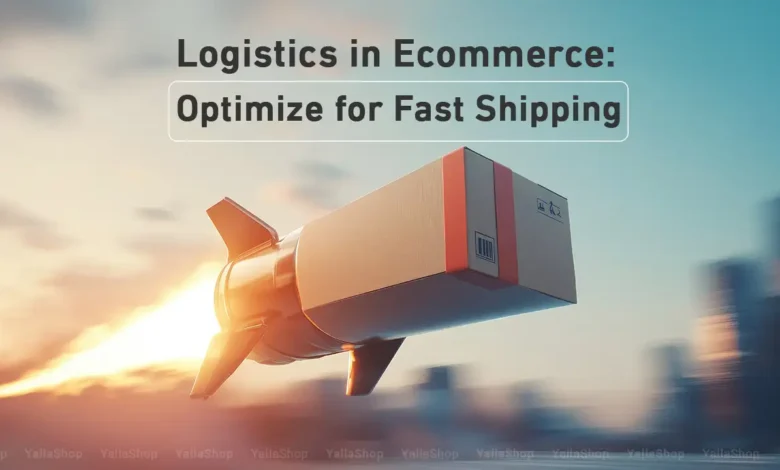
In the fast-paced world of e-commerce, logistics in e commerce serves as the unsung hero behind seamless customer experiences. From the moment a customer places an order online to the final delivery at their doorstep, logistics in e-commerce ensures everything operates smoothly. It is not merely about moving goods from one place to another; it involves an intricate process of planning, coordination, and execution to meet the ever-rising expectations of modern consumers.
As online shopping continues to dominate the retail landscape, businesses must prioritize logistics to remain competitive. Efficient logistics systems can significantly enhance customer satisfaction and streamline operating costs.
✨ Build your dream. Sell with YallaShop.
Your online store is just one click away.
🚀 No tech skills needed. No delays. Just you, your products, and a fresh start.
Click below and turn your idea into income — today.
What is Logistics in E-Commerce?
Logistics in e-commerce is the management of acquiring, storing, and delivering resources efficiently to their final destination. It involves planning, implementing, and controlling the movement of goods within a systematic framework to achieve specific business goals. In essence, logistics ensures that the right product reaches the right place at the right time. This process is vital in various industries, but its importance is amplified in e-commerce, where customer satisfaction hinges on timely and accurate deliveries.
Logistics in e-commerce includes several elements: inventory management, warehousing, transportation, and last-mile delivery. Each of these components must work seamlessly to ensure that businesses can meet the high expectations of online shoppers. From ensuring real-time stock visibility to facilitating quick order fulfillment, logistics plays a pivotal role in keeping e-commerce businesses competitive.
Read More about e commerce in egypt: Transforming How People Shop Today
The Importance of Logistics in E-Commerce
the logistics in e commerce process sector thrives on convenience and efficiency. Unlike traditional retail, e-commerce lacks a physical storefront where customers can pick up products. Instead, businesses rely on logistics to bridge the gap between online orders and physical delivery. Effective logistics in e commerce systems enhance customer satisfaction, streamline operations, and improve profitability.
Consider this scenario:
A customer places an order for a product that’s out of stock. Without proper inventory management, the business may confirm the order, only to inform the customer later that the product is unavailable. Such situations harm the company’s reputation and may lead to negative reviews. By implementing robust logistics systems, businesses can avoid these pitfalls and build trust with their customers.
Key Components of Logistics in E-Commerce
1. Inventory and Warehouse Management
Inventory management ensures that businesses have the right products available at the right time. This involves tracking stock levels, monitoring product movements, and anticipating demand fluctuations. With the help of inventory management software, businesses can maintain optimal stock levels, reducing the risk of overstocking or running out of products in logistics in e commerce.
Warehousing, on the other hand, involves the storage of products before they are shipped to customers. A well-organized warehouse improves operational efficiency by streamlining the picking, packing, and shipping processes. Advanced Warehouse Management Systems (WMS) allow businesses to automate these tasks, ensuring accuracy and speed.
2. Order Processing
Order processing begins the moment a customer completes a purchase on an e-commerce platform. This stage involves several steps, including order confirmation, picking the product from the warehouse, packaging, and labeling it for shipment. Efficient order processing systems minimize delays and errors, leading to faster deliveries and higher customer satisfaction.
For smaller e-commerce businesses, order processing may be handled manually. However, as the business grows, automating this process becomes essential to manage the increased order volume effectively.
3. Transportation and Last-Mile Delivery
Transportation is the backbone of e-commerce logistics, responsible for moving products from warehouses to customers. Last-mile delivery, the final stage in the logistics chain, is particularly crucial as it directly impacts the customer experience.
Last-mile delivery is often the most challenging and expensive part of logistics. logistics in e commerce businesses must navigate traffic, optimize delivery routes, and manage customer preferences, all while maintaining cost efficiency. Technologies such as route optimization software and real-time tracking help businesses overcome these challenges, ensuring timely and accurate deliveries.
Read More about logistics in e commerce: Optimize for Fast Shipping
Challenges in E-Commerce Logistics
Logistics in e-commerce is not without its challenges. As the industry continues to grow, businesses must navigate a range of issues, including:
- Demand Volatility: E-commerce logistics companies often experience fluctuations in demand, especially during sales events or holiday seasons. Managing inventory and logistics during these peak periods requires careful planning and flexibility.
- High Customer Expectations: Online shoppers expect fast, free, and reliable delivery. Meeting these expectations while maintaining profitability can be a significant challenge.
- Return Logistics: Managing returns, also known as reverse logistics, is a complex process that requires additional resources and coordination. Businesses must streamline this process to maintain customer satisfaction and minimize losses.
Best Practices for Optimizing E-Commerce Logistics
1. Invest in Smart Warehouse Design
A well-organized warehouse layout reduces the time and effort required to pick and pack orders. By grouping similar products together and using technologies like automated storage and retrieval systems, businesses can improve operational efficiency and reduce errors.
2. Leverage Real-Time Tracking
Real-time tracking systems provide visibility into the movement of goods throughout the supply chain. These systems not only help businesses monitor inventory but also allow customers to track their orders, enhancing transparency and trust.
3. Optimize Last-Mile Delivery
To improve last-mile delivery, businesses can use route optimization software, employ local delivery partners, or even invest in innovative solutions like drone deliveries. Ensuring that customers receive their orders on time is key to building loyalty and driving repeat business.
4. Streamline Return Processes
A seamless return process is essential for maintaining customer satisfaction. Businesses can achieve this by setting up dedicated return portals, offering free return shipping, and using automated systems to process returned items quickly.
Read More about Impact of e-commerce on business strategy
The Role of Technology in Logistics
Technology has transformed the logistics in e commerce landscape, enabling businesses to achieve greater efficiency and scalability. Tools such as Warehouse Management Systems, Transportation Management Systems, and Artificial Intelligence (AI) are revolutionizing how logistics operations are conducted.
For example, AI-powered analytics can predict demand patterns, helping businesses optimize inventory levels. Similarly, automation technologies such as robotics and conveyor systems streamline warehouse operations, reducing labor costs and improving accuracy.
Frequently Asked Questions
1. What is the meaning of logistics in commerce?
Logistics in commerce refers to the process of planning, managing, and executing the movement of goods, services, or information to meet customer demands efficiently.
2. What is the relationship between e-commerce and logistics?
E-commerce relies on logistics to ensure seamless order processing, inventory management, and delivery, directly impacting customer satisfaction and operational efficiency.
3. What is the logistics chain of e-commerce?
The e-commerce logistics chain includes inventory management, order processing, warehousing, transportation, last-mile delivery, and reverse logistics for returns.
Conclusion
Logistics in e-commerce is the lifeblood of e-commerce, ensuring that products move seamlessly from suppliers to customers. By investing in advanced technologies, adopting best practices, and overcoming logistical challenges, businesses can create a competitive edge in the dynamic e-commerce logistics landscape.
In today’s digital age, where convenience and speed reign supreme, efficient logistics systems are not just a necessity—they are a critical driver of success. Whether you’re a small startup or a large enterprise, mastering logistics will pave the way for sustainable growth and customer satisfaction in the ever-evolving world of e-commerce.


I truly appreciate your technique of writing a blog. I added it to my bookmark site list and will
I appreciate you sharing this blog post. Thanks Again. Cool.